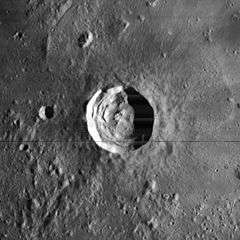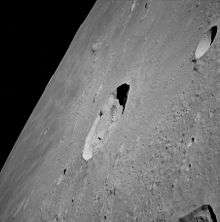Kepler (lunar crater)
|
Lunar Orbiter 4 image | |
| Coordinates | 8°06′N 38°00′W / 8.1°N 38.0°WCoordinates: 8°06′N 38°00′W / 8.1°N 38.0°W |
|---|---|
| Diameter | 32 km |
| Depth | 2.6 km |
| Colongitude | 38° at sunrise |
| Eponym | Johannes Kepler |
Kepler (Latin Keplerus) is a lunar impact crater that lies between the Oceanus Procellarum to the west and Mare Insularum in the east. To the southeast is the crater Encke.
Kepler is most notable for the prominent ray system that covers the surrounding mare. The rays extend for well over 300 kilometers, overlapping the rays from other craters. Kepler has a small rampart of ejecta surrounding the exterior of its high rim. The outer wall is not quite circular, and possesses a slightly polygonal form. The interior walls of Kepler are slumped and slightly terraced, descending to an uneven floor and a minor central rise.
One of the rays from Tycho, when extended across the Oceanus Procellarum, intersects this crater. This was a factor in the choice of the crater's name when Giovanni Riccioli was creating his system of lunar nomenclature, as Kepler used the observations of Tycho Brahe while devising his three laws of planetary motion. On Riccioli's maps, this crater was named Keplerus, and the surrounding skirt of higher albedo terrain was named Insulara Ventorum.
Due to its prominent rays, Kepler is mapped as part of the Copernican System.[1]
Satellite craters
By convention these features are identified on lunar maps by placing the letter on the side of the crater midpoint that is closest to Kepler.
| Kepler | Latitude | Longitude | Diameter |
|---|---|---|---|
| A | 7.2° N | 36.1° W | 11 km |
| B | 7.8° N | 35.3° W | 7 km |
| C | 10.0° N | 41.8° W | 11 km |
| D | 7.4° N | 41.9° W | 10 km |
| E | 7.4° N | 43.9° W | 6 km |
| F | 8.3° N | 39.0° W | 7 km |
| P | 12.2° N | 34.0° W | 4 km |
| T | 9.0° N | 34.6° W | 3 km |
 Kepler D crater
Kepler D crater
References
- ↑ The geologic history of the Moon, 1987, Wilhelms, Don E.; with sections by McCauley, John F.; Trask, Newell J. USGS Professional Paper: 1348. Plate 11: Copernican System (online)
| Wikimedia Commons has media related to Kepler (crater). |
- Wood, Chuck (2006-07-05). "A Smarter Kepler". Lunar Photo of the Day. Retrieved 2006-07-12.
- Andersson, L. E.; Whitaker, E. A. (1982). NASA Catalogue of Lunar Nomenclature. NASA RP-1097.
- Blue, Jennifer (July 25, 2007). "Gazetteer of Planetary Nomenclature". USGS. Retrieved 2007-08-05.
- Bussey, B.; Spudis, P. (2004). The Clementine Atlas of the Moon. New York: Cambridge University Press. ISBN 978-0-521-81528-4.
- Cocks, Elijah E.; Cocks, Josiah C. (1995). Who's Who on the Moon: A Biographical Dictionary of Lunar Nomenclature. Tudor Publishers. ISBN 978-0-936389-27-1.
- McDowell, Jonathan (July 15, 2007). "Lunar Nomenclature". Jonathan's Space Report. Retrieved 2007-10-24.
- Menzel, D. H.; Minnaert, M.; Levin, B.; Dollfus, A.; Bell, B. (1971). "Report on Lunar Nomenclature by the Working Group of Commission 17 of the IAU". Space Science Reviews. 12 (2): 136–186. Bibcode:1971SSRv...12..136M. doi:10.1007/BF00171763.
- Moore, Patrick (2001). On the Moon. Sterling Publishing Co. ISBN 978-0-304-35469-6.
- Price, Fred W. (1988). The Moon Observer's Handbook. Cambridge University Press. ISBN 978-0-521-33500-3.
- Rükl, Antonín (1990). Atlas of the Moon. Kalmbach Books. ISBN 978-0-913135-17-4.
- Webb, Rev. T. W. (1962). Celestial Objects for Common Telescopes (6th revised ed.). Dover. ISBN 978-0-486-20917-3.
- Whitaker, Ewen A. (1999). Mapping and Naming the Moon. Cambridge University Press. ISBN 978-0-521-62248-6.
- Wlasuk, Peter T. (2000). Observing the Moon. Springer. ISBN 978-1-85233-193-1.


